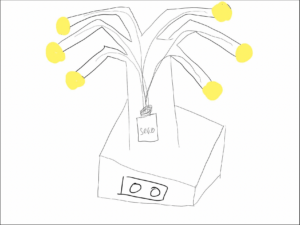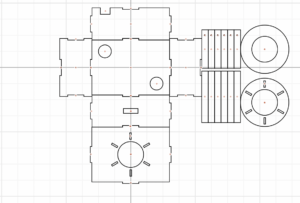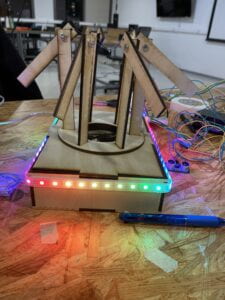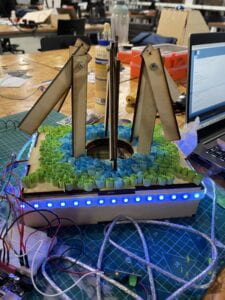Breathe – Luciana Emerson – Rudi
CONCEPTION AND DESIGN:
My partner and I wanted to create something meaningful for our final project. We decided to create something that would cater to people who suffer from anxiety. We knew we couldn’t just slap on the title “anti-anxiety” without doing research so we started by looking up ways to calm people down from anxiety attacks. We first hoped to use heartbeat monitors to trigger the use of our project but we decided that there were too many variables that came with that. For example, everyone has a different heart rate so we couldn’t make a general variable to declare that someone was having anxiety. During user testing, we had a motion sensor on the lamp. Though people liked the idea they thought it would be more meaningful if the lamp could detect anxiety. We noticed that many people who suffer from anxiety start to fidget. We decided that the best way to trigger the start of our device would be to put a vibration sensor on the floor so when people began to shake their legs, the device would activate. We also know that sometimes being told you have anxiety is just another trigger so we also kept the motion sensor so people can use it if they notice they are stressed and need to take a break. When doing research we found that some colors also decrease anxiety. We used the top three: green, blue, and purple. Some people use music to decrease stress so we also added low-fi music for when the lamp starts to activate. During user testing, many people said that our lamp looked very plain. They recommended we decorate it to look more interesting. Because of this, we turned our lamp into a tree because many people see nature as a calming landscape. We also initially had a smaller box that just held the pulley mechanism. We wanted to clean up all the wires so they wouldn’t look so chaotic. For our final, we created a bigger box that held the Arduino, breadboard, and Bluetooth speaker.
FABRICATION AND PRODUCTION:
When my partner and I were first thinking about how to create an anxiety-decreasing lamp we thought about different sensory movements. We even thought about making a hologram coming out of the top of the lamp. We decided that using a pulley system on the tree branches would be the best idea because it is not overstimulating and it coached the user on how to breathe properly to decrease stress. The idea was that as the branches rose, the user would inhale, and as they fell the user would exhale. We liked this idea because we didn’t want to create a device that would be pushy or annoying so even if the user didn’t want to match their breath up, they could still enjoy the experience. At the beginning of the project we also wanted to put lights on the ends of the trees but we thought that the messy wire might become a trigger for anxiety. For user testing, we had a lullaby as the music that started playing. We switched it over to low-fi beats because we didn’t want the music to become catchy or annoying. We also initially had the LED’s rainbow but we switched it over to a calming blue because we didn’t want the user to get overwhelmed by the vibrant colors. We wanted our lamp to sense when a user was feeling anxiety but we didn’t want them to feel pushed into trying to calm themselves down. We decided to incorporate two sensors. The first was a motion sensor that would start the movement of the branches and activate the music. This sensor was for when the user acknowledged they needed a break. The user would wave their hand over it to start the lamp and then wave it again to stop it. The second sensor was the vibration sensor which would only move the lamp up and down once to remind the user to breathe. The vibration sensor would not activate any music.
When we finally settled on the design we wanted we decided that we both would work on a bit of everything. My partner was very advanced in coding and I wanted to be there to learn how to do more. On the last day before presenting she, unfortunately, got COVID. Because she taught me more about coding I was able to fix the bugs that were still left in our code. Before coming to NYUSH I had a background in CAD. So just as she taught me how to code, I taught her how to use CAD so we could cut out our pieces on the laser cutter.
Initial sketch
CONCLUSIONS:
My partner and I wanted to create something that would help people. We decided on an anti-anxiety desk lamp that would help students reduce stress. I think that we were very successful when making our project because we tried to incorporate a lot of calming aspects as well as taking into account different triggers. When people first walked up to our project during user testing they didn’t know exactly how to interact with it but as the lamp started moving, they would look entranced. When they were done all of them would say that it was very relaxing to look at. I think that one difficulty we faced with the project was more interactive. During user testing, we only had the motion sensor. Though I would argue that is interactive, it was very similar to my midterm project. I wanted to add other variables to challenge myself for the final project. This project matches my definition of interaction because, based on the different sensors, it responds differently. With the motion sensor, the lamp will play music and move until you stop it where as the vibration sensor will only move once without music. I think that because the lamp has different responses, it really creates a conversation between the user and the device. This project was assigned right when the COVID restrictions were getting lifted in China. Because of this everyone was getting sick. I think that this project taught me resilience and dedication as both my partner and I kept having to adapt in order to complete the project. Throughout the world, mental health is stigmatized. I believe that mental health needs to be talked about in order for people to feel safe while talking about the struggles that they face. We created this project in hopes that people will see that even the smallest things can have a major impact.
- ANNEX
All technical documentation that was not included in previous sections should be attached here. Upload your code (copied as HTML) from both Processing and Arduino, wiring diagrams made in TinkerCad Circuits, pictures, videos and all related documentation that would help to understand the technical development process. If you used code or assets from outside sources, properly cite them.
Cuttle box design
The first iteration of the box
User testing
The second iteration of the box
The final iteration of the box.




Leave a Reply